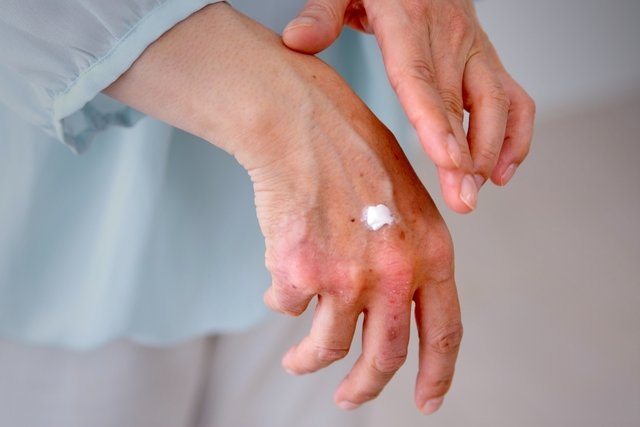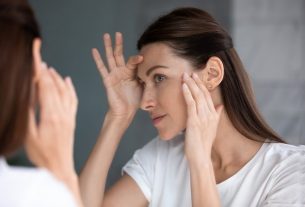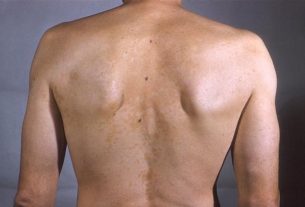The appearance of spots on the skin can happen due to prolonged exposure to the sun or be related to hormonal changes that occur during pregnancy, for example. Furthermore, spots on the skin can also be caused by allergies, diabetes, changes in the function of melanocytes, as is the case with vitiligo, or be a consequence of a fungal infection, for example.
As a consequence of these situations, it is possible that there is greater stimulation of melanin production by melanocytes, promoting the appearance of darker spots on the skin.
It is important that the cause of the spot on the skin is properly identified by the dermatologist, as this way it is possible to start the most appropriate treatment to lighten the spot and prevent it from growing, which can be done by using daily sunscreen and lightening creams.
Main causes
The main causes of skin blemishes are:
1. Hormonal changes
Some hormonal changes, especially those that occur due to pregnancy or menopause, can lead to the appearance of blemishes, especially near the cheekbones and forehead. In this case, these hormonal changes stimulate melanocytes, which start to produce more melanin and leave darker areas in certain areas of the face. These spots tend to get darker when a person is exposed to the sun for a long time.
How to take: Apply sunscreen with maximum protection factor daily and avoid prolonged exposure to the sun, as well as heat sources, avoiding getting into hot cars parked in the sun or using the oven, for example. In addition, you can apply a cream or ointment to lighten the skin according to the dermatologist’s instructions.
Hydroquinone may be indicated, but should not be used for more than 4 weeks. Other options include Vitanol A, cream with acids such as Klassis, or Adapalene, for example.
2. Prolonged exposure to the sun
Sun spots occur more frequently in people with fair or dark skin who are exposed to the sun a lot without using sunscreen. The most affected parts of the body are the hands, arms, face and neck, and although it is more common after the age of 40, it can also appear in younger people.
How to take: The lighter and more superficial ones can be eliminated with exfoliation every 2 weeks. When there are a greater number of spots, it is recommended to go to the dermatologist so that more suitable products can be recommended.
This is important because when a person has many spots of this type, they have a higher risk of skin cancer and this doctor will be able to assess whether the spots they have have this risk or not. The use of whitening creams can be a good option, but aesthetic treatments such as laser, pulsed light and peeling also have great results.
3. Allergy
Allergy is also a frequent cause of spots on the skin, which tend to be very itchy and red or brown depending on the triggering factor. Allergy spots can appear after consuming allergenic foods, such as shrimp, strawberries or peanuts, for example, after applying products to the skin, such as creams, perfumes or cosmetics, or wearing objects in contact with the skin, such as bracelets or necklaces. .
How to take: It may be recommended to apply a corticosteroid-based cream twice a day, until symptoms subside. It is recommended to consult a dermatologist to identify the cause of the allergy, so that contact with what caused the allergy can be avoided.
4. White cloth
White cloth, popularly known as beach mycosis and scientifically as pityriasis versicolor, is a skin disease caused by the fungus Malassezia furfurwhich is capable of preventing the production of melanin, resulting in white spots on the skin.
This disease is often associated with the beach because it is normally noticed after exposure to the sun, where the areas where the fungus has proliferated turn white at the same time as the rest of the skin becomes tanned. See more about white cloth.
How to take: In this case, it is recommended to apply an antifungal cream to the skin, twice a day, for 3 weeks. When the area to be treated is very large, involving the entire back, it may be necessary to take an oral antifungal, such as itraconazole, under medical advice.
5. Lemon stain
Phytophotodermatitis is the scientific name for skin lesions caused by lemon. All it takes is for the lemon to come into contact with the skin and the person to be exposed to the sun immediately afterwards, and the skin reacts, which can cause a burn or lead to the appearance of small dark spots on the skin, especially on the hands.
How to take: After the inflammatory phase, wash the skin well, apply a cream with hydroquinone once a day, and avoid placing products, such as perfumes or cosmetics, on the affected area. Furthermore, it is also important to always use sunscreen on the affected area, so that the treatment is effective.
6. Diabetes
Acanthosis nigricans is the scientific name for dark spots that appear around the neck, skin folds, armpits and under the breasts, in people who have insulin resistance or diabetes. Learn more about acanthosis nigricans.
How to take: You should consult a dermatologist, who will prescribe whitening creams and identify the cause of acanthosis nigricans. Furthermore, when it is caused by excess weight, the patient must lose weight because this will facilitate the treatment to even out the skin tone.
7. Vitiligo
Vitiligo is a disease that leads to the appearance of white spots on the skin, especially in places such as the genitals, elbows, knees, face, feet and hands. Vitiligo can appear at any age and its causes are not yet known.
How to take: It is recommended to consult a dermatologist to start the appropriate treatment according to each case. Treatment for vitiligo aims to reduce the appearance of spots and prevent changes in sensitivity in the area, and phototherapy sessions and the use of medications to stimulate the production of melanin may be recommended. See more details on vitiligo treatment.
8. Acne
Pimple scars are a very common cause of skin blemishes in young teenagers, appearing mainly after the treatment of severe acne, for example.
How to take: A good treatment for acne spots is to apply rosehip oil 2 to 3 times a day on the scar, avoiding exposure to the sun. Furthermore, it is also important to keep skin oil under control with anti-acne treatments.
When the person no longer has any blackheads or pimples, treatments can be indicated to lighten the skin, such as the use of creams with acids, acid peeling, microneedling and aesthetic treatments such as laser or pulsed light.
9. COVID-19
Infection with SARS-CoV-2 can lead to the appearance of some red or purple spots, of varying sizes, on the skin due to inflammation of this organ, which can appear on the hands, soles of the feet, legs, arms, trunk or back, in some cases. Spots due to COVID-19 may appear a few weeks after the onset of typical symptoms of the disease, such as body pain, headache, fever, sore throat and general malaise, for example. Know how to recognize the symptoms of COVID-19.
How to take: COVID-19 spots usually improve over the weeks without the need for any treatment. However, if it is causing discomfort or itching, for example, it is recommended that a dermatologist be consulted, as this may indicate the use of topical medications to relieve discomfort and reduce inflammation.
How to remove birthmarks
Birthmarks can be reddish or darker than the skin tone, and generally do not respond well to any type of treatment, being a characteristic that the person has. But when it causes a lot of embarrassment, the person can go to the dermatologist to evaluate the treatments that may be recommended, because it will depend on its location and the depth of each spot.
Acid peeling that removes the outermost and intermediate layer of the skin and laser treatment may be some recommended options for removing this type of skin blemish. Getting a tattoo taking advantage of the shape and location of the stain can also be a more positive way of living in peace with the stain.
Care to increase treatment success
The 4 essential precautions to prevent the appearance of new spots on the skin, and to prevent those that already exist from becoming even darker, are:
- Always apply sunscreen with a high protection factor before leaving the house;
- Moisturize the skin of the entire body and face daily, with creams suitable for each type;
- Avoid excessive sun exposure;
- Do not squeeze pimples or blackheads, which can leave dark marks on the skin.

Sign up for our newsletter and stay up to date with exclusive news
that can transform your routine!
Warning: Undefined array key "title" in /home/storelat/public_html/wp-content/plugins/link-whisper-premium/templates/frontend/related-posts.php on line 12
Warning: Undefined array key "title_tag" in /home/storelat/public_html/wp-content/plugins/link-whisper-premium/templates/frontend/related-posts.php on line 13




